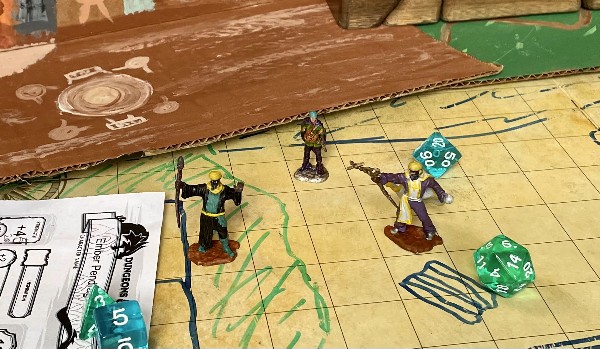You touch a creature and can end either one disease or one condition afflicting it. The condition can be blinded, deafened, paralyzed, or poisoned.
Casting Time: 1 action
Range: Touch
Components: V, S
Duration: Instantaneous
School: 2nd-level abjuration
Who can cast Lesser Restoration? Bards, Clerics, Druids, Paladins, Rangers, and Artificers have Lesser Restoration on their class spell lists. Life Clerics and Devotion Paladins get Lesser Restoration for free, and always have it prepared.
Celestial Warlocks and Divine Soul Sorcerers also have Lesser Restoration added to their spell lists. Alchemist Artificers can cast Lesser Restoration without expending a spell slot or preparing the spell starting at 9th level.
Lesser Restoration 5e
Lesser Restoration is a no-nonsense spell that instantly cures a disease or common condition that’s afflicting you or your ally in DnD 5e. While the conditions that Lesser Restoration resolves are limited, it’s only a second-level spell, so it is well worth keeping around at later levels.
How Does Lesser Restoration Work in 5e?
Lesser Restoration instantly removes one disease or one condition from a creature you touch. The conditions you can end with Lesser Restoration include:
-
Blinded
-
Deafened
-
Paralyzed
-
Poisoned
How to Use Lesser Restoration in 5e
Lesser Restoration has a straightforward use, but it also has some fun alternative uses:
-
Restoring allies. Lesser Restoration’s main function is to restore important allies (including yourself) back to fighting condition. This can be a short-term boon in a tough fight or a long-term benefit for parties that explore disease-laden locations far from a healer’s temple.
-
Downtime side gig. Depending on your DM and party’s preferences, downtime activities can be a fun way to flesh out your character’s life outside of adventures.
Seeing as parties without healers and wizards are always running to temples and mage towers for spells like Lesser Restoration and Identify, it’s perfectly reasonable that you yourself could sell these services.
The rules even suggest that spells like Cure Wounds and Identify “might cost 10 to 50 gold pieces” — it’s fair to say that Lesser Restoration would fetch a similar price from folks in need.
-
Charlatanism. Maybe you’re not so interested in earning cash off your divine powers, but how about starting a following among village bumpkins? Making a great display of your restorative powers could even make you something of a legend, especially if you only pass through at certain intervals or demand strange rituals in return for your service.
-
Save it for mid-late game. If you’re trying to optimize your spell selection early in a DnD campaign, you know that spell slots are not easy to come by. There also aren’t too many monsters sporting scary disease effects, and if you do happen to pick one up, you can usually find a Cleric to clear it up in exchange for some gp.
But in the later game, with more spell slots, more marathon-like dungeon crawls, and more common disease effects in the world, having a cheap second-level spell at the ready is a huge boon for any party.
-
Sobering someone up. You know that expression bartenders use, “what’s your poison?” Alcohol is technically poisonous, and since Lesser Restoration cures the effects of poison, the spell should work as an instant sobriety-inducer or hangover cure.
If you’re doubtful, here’s Mike Mearls confirming that alcohol is indeed treated as a poison in DnD 5e. And the WoTC staff also confirmed that it’ll work on Sage Advice.
Yes! We had alcohol rules in the playtest, treated it as poison there. https://t.co/oXYmIDVhBE
— Mike Mearls (@mikemearls) January 24, 2016
-
Clearing up paralysis. Blind and deafen effects are usually short-term enough to render Lesser Restoration unnecessary. But long-term paralyze effects, like Hold Person, can really hurt your party’s total power level in a fight. Lesser Restoration is a quick way to get the fight back in your favor.
What Are the Rules for Lesser Restoration in 5e?
The rules for Lesser Restoration in DnD 5e are as follows:
-
Lesser Restoration removes one total effect. Either one disease or one of the conditions listed.
-
Lesser Restoration has no effect on exhaustion. Spells only do what they say they do, and exhaustion is not mentioned in Lesser Restoration’s spell description. Greater Restoration, however, does work to reduce the target’s exhaustion level.
-
Lesser Restoration has no effect on curses, however, it may be able to end a condition caused by a curse if the curse’s source is a spell.
-
Lesser Restoration cannot cure lycanthropy. Lycanthropy is a curse, and so outside of the powers of Lesser Restoration to cure.
-
Lesser Restoration cannot cure permanent/innate blindness or deafness. Lesser Restoration ends a condition, two of which are sometimes contentious at DnD tables. Blindness and Deafness, as conditions, are the “result of a spell, a class feature, a monster’s attack, or other effect.”
That “other effect” certainly leaves the door open to natural or physically-caused blindness/deafness, and nobody would argue that a regular humanoid who was born blind wouldn’t suffer from the Blinded condition in 5e.
However, it feels a little strong for a 2nd-level spell to perform the work of literal miracles. Especially with a 7th-level spell like Regenerate being 5e’s version of medical miracle-working.
Who Can I Target With Lesser Restoration 5e?
You can target any creature you can touch with Lesser Restoration, including yourself. Touch implies that you must be on an adjacent square if you’re using a grid battle map.
Divine Soul Sorcerers can use the Distant Spell metamagic to extend Lesser Restoration’s range to 30 feet, and Celestial Warlocks can use their Find Familiar to cast Lesser Restoration on an ally up to 100 feet away, so long as the familiar is within touch range of that ally.
Is Lesser Restoration 5e a Good Spell?
Yes, Lesser Restoration is a good spell. It has limited uses and doesn’t get much play in the early game, but as you progress through your campaign, you’ll always want one party member to have this spell in their arsenal.
It allows for a heavy-hitting ally to rejoin the fray, a healer to escape a bad situation, or for that silly party member that keeps triggering disease traps to keep enjoying their life of regret-free curiosity.
Lesser Restoration 5e Compared to Greater Restoration
A 5th-level spell, Greater Restoration is, well, greater in potency than Lesser Restoration. It removes charms, petrifies, curses (including attunement to cursed items), ability score reductions, and effects reducing the target’s hit point maximum.
What it doesn’t do is remove diseases or the four minor conditions that Lesser Restoration does. For that reason, Greater Restoration doesn’t really replace Lesser Restoration. Rather, it expands on the lesser spell’s effects and allows for a dedicated healer to cover (almost) all their bases with regard to negative effects placed on allies.
Remove Curse is a third-level spell that does exactly what it says (removes a curse) and nothing else. All three spells have their place in a healer’s toolkit, and none becomes obsolete as you level.
DnD 5e Lesser Restoration FAQ
Lesser Restoration DnD 5e FAQ:
-
Can Lesser Restoration heal? No, Lesser Restoration does not restore lost hit points; it removes certain conditions: blinded, deafened, paralyzed, or poisoned.
-
Is Lesser Restoration a ritual? No, Lesser Restoration is not a ritual spell. It requires an action to cast.
-
Can Lesser Restoration regrow limbs? No, Lesser Restoration cannot regrow limbs. The spell that can regrow limbs is Regenerate, a 7th-level spell.
-
Does Lesser Restoration remove madness? No, according to the rules as written (RAW), Lesser Restoration does not remove madness. However, a Dungeon Master may choose to allow it in their campaign.
-
Does Lesser Restoration cure mummy rot? No; same reason as above.
-
Does Lesser Restoration cure fear? No, Lesser Restoration does not cure fear. The frightened condition is not one of the conditions that Lesser Restoration can remove.
Simple Lesser Restoration 5e Spell Text
Lesser Restoration: (2nd-level, touch, V/S) Remove one of the following effects: disease, blind, deafen, paralyze, poison.
How Other Abjuration Spells Work in DnD 5e
Absorb Elements D&D
Armor of Agathys D&D
Ceremony D&D
Mage Armor D&D
Sanctuary D&D
Shield D&D
Shield of Faith D&D
Aid D&D
Pass Without Trace D&D
Dispel Magic D&D


![Mold Earth 5e [DnD Spell Guide: Uses, Rules, Tips] firbolg-druids-dnd-5e](https://www.dndlounge.com/wp-content/uploads/2023/04/firbolg-druids-dnd-5e.png)
![Barkskin 5e [DnD Spell Guide: Uses, Rules, Tips] dungeons-and-dragons-party-vs-troll-minis](https://www.dndlounge.com/wp-content/uploads/2022/03/dungeons-and-dragons-party-vs-troll-minis-300x200.jpg)
![Fly 5e [DnD Spell Guide, Tips, Rules, Uses] misty-step-5e](https://www.dndlounge.com/wp-content/uploads/2022/03/misty-step-5e-300x161.jpg)
![Flaming Sphere 5e [DnD Spell Guide: Uses, Rules, Tips] find-familiar-5e](https://www.dndlounge.com/wp-content/uploads/2022/03/find-familiar-5e-300x159.jpg)